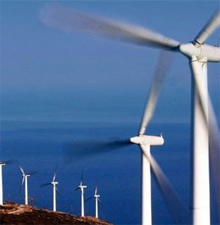Starting essentially from scratch just a few years ago, China has overtaken the U.S. in a number of ways. That now includes being the country with most installed wind power capacity. China has more than 80 wind turbine manufacturers, four of which are among the top 10 globally by market share. By the end of last year, it had 45 gigawatts (GW) of installed wind power, up 73% from 26 GW in 2009, compared with 40 GW in the U.S., according to the Brussels-based Global Wind Energy Council. And China's government intends to raise total wind power capacity even further, to 100 GW by 2015 and 200 GW by 2020.
Louis Schwartz, a U.S. lawyer and specialist in Chinese energy, says China's officials have spoken off the record of targets that are even higher, reaching 150 GW by 2015 and 250 GW by 2020.“I am optimistic about the likely growth of wind power in China and I think they are likely to be very successful in putting in place a tremendous amount of wind power in China,” says Schwartz, who is also president of a Pittsburgh, Pennsylvania consulting firm, China Strategies.
Whatever the statistic or forecast, growth is assured. But for how long and at what price? Having a big market share is one thing; being a profitable, well-run company is another. Thanks to China's quirks, the realities of its wind business is as contradictory as it is complicated. Like many other burgeoning Chinese industries, the wind turbine sector is now overcrowded and highly fragmented, as players — (relatively) old and new, foreign and local — jostle for a cut.
Home Advantage
Before China’s wind energy market really took off around five years ago, there were roughly 10 foreign and local wind turbine manufacturers in China, according to Jens Tommerup, president of the China arm of Denmark’s Vestas, Danish firm with US$9.8 billion (RMB 63.4 billion) of annual revenue, which commands a world market share of nearly 15%."At that point, non-Chinese manufacturers had the majority of the market," he says. But last year, while the number of non-Chinese manufacturers remained largely the same, the number of Chinese manufacturers increased to more than 70. The foreign share of China's wind business plummeted to 10.5% from 75% in 2005. Amid the state of flux, top foreign turbine makers are by no means suffering, even if their overall market share has declined.
While growth is widely expected to continue, it is likely to be under different conditions. Beijing’s recent decision to open the market fully to foreign manufacturers is one reason; the end of its subsidies for local makers — after getting slapped by a U.S. complaint to the World Trade Organization following years of tensions over the issue — is another. But those steps are a reflection of the government's growing confidence in the competitiveness of domestic companies and its aim to bring advanced technologies like wind energy on to the map of mainstream investors and end users.
Yet China's turbine makers have a meager presence in world markets and nearly all their growth has been at home. In 2010, only one Chinese company among the country’s top four, Goldwind, exported wind turbines — 4.5 megawatts (MW) to Cuba, which accounted for 0.12% of Goldwind’s total new installations of 3,739.5 MW last year.
Goldwind is targeting markets in the U.S., Europe, Australia and Africa and expects its overseas business to account for between 20% and 30% of sales within five years. That's a tall order. It currently only has 9.5% of the global market share. Along with China’s Sinovel at 11.1% and Dongfang at 6.7%, other leaders included GE Wind of the U.S. at 9.6%; Enercon of Germany at 7.2%; and Suzlon of India at 6.9%, according to a report titled, "International Wind Energy Development Market 2010," by Denmark-based BTM Consult.
China’s commitment to expanding the use of wind power and other renewables is unquestionable. By increasing the share of non-fossil fuels in its overall energy mix, the country intends to reduce its carbon emissions intensity per unit of GDP by 40% to 50% by 2020. To meet that goal, it has to increase renewable sources in its total energy use to 15% by 2020 from 8.5% in 2010. Out of the 41,932 GW of electricity consumed by China in 2010, wind power accounted for only about 1.6%.
But there are plenty of obstacles. For example, according to Dave Dai, regional head of clean energy and utilities research at Daiwa Capital Markets (DCM) in Hong Kong, China wastes more than 30% of the wind power that is generated in the country. Part of the reason is the power transmission bottlenecks. "Most of its rich wind resources are located in the north and west while the power demand is in economic centers in eastern and southern China," he says. "So long-distance, high-voltage transmission projects are required to support long-term growth.”
The provinces with the biggest installed wind power capacity in 2010 were Inner Mongolia, which is sometimes described as the Saudi Arabia of China’s wind power, with 13.38 GW; Gansu (4.9 GW); Hebei (4.9 GW); Jilin (2.9 GW); Liaoning (4.1 GW) and Shandong (2.6 GW).
While installations have expanded at exponential rates, China’s power grid investments have fallen behind, says Dai. “So there is only a maximum amount of new capacity the grid can add per year.” According to State Grid Corporation, less than 30 GW of the country’s installed capacity of 45 GW was connected to the grid at the end of 2010. Of the unconnected capacity, three-quarters is in Inner Mongolia, says the State Electricity Regulatory Commission (SERC). A lack of overall transmission capacity between State Grid in the north and China Southern Grid further compounds the problem.
Geographic distance is not the only challenge. Small wind farms of less than 50 MW capacity have proliferated randomly. Projects larger than that require central government approval, which often takes as long as two years. The National Development and Reform Commission (NDRC), the main regulator for wind power, is considering moving the approval of sub-50 MW projects from the provincial level to the state level "so that State Grid can plan and control grid connections for those smaller projects,” says Feng Zhao, a senior wind power consultant at BTM Consult in Denmark.
China added between 16 GW and 17 GW wind per installed capacity a year in the past three years, and between 12 GW and 14 GW were being connected, Dai says. Now, State Grid is investing RMB 500 billion (US$77 billion) to build high voltage transmission lines from the north to the south from 2012 to 2013 and three lines with total capacity of 30 GW, which is enough for two years’ growth. “China needs a new line every year,” he adds. The government has said it wants to invest RMB 2 trillion on building a smart grid between 2011 and 2015.
Follow the Renmimbi
Another problem facing the wind industry has to do with the quirkiness of China's rapid growth. “It is almost like perfect capitalism — get a market growing tremendously and everyone jumps into it," says Schwartz of China Strategies. "Too many companies got into the wind turbine market.” But most of the 80 or so companies in the sector are not making wind turbines.
“I checked the financial data of all 80 Chinese wind turbine makers and found only 30 of them had actually installed wind turbines in the past three years,” says BTM’s Zhao. “Everyone wants to get into a good business. They went for the money. Some of them were in small, remote cities and did not have any technology to make wind turbines. They thought they could cooperate with a foreign company to get a license, but the deals never worked out.”
BTM's report shows the top five Chinese wind turbine makers — Sinovel, Goldwind, Dongfang, United Power and Mingyang — commanding more than 70% of China’s market. But with competition heating up, prices have plunged 50% over the past five years, to half the levels in Europe at RMB 3,800 per kilowatt. “They made prices so low that non-Chinese companies cannot compete,” laments a foreign wind power executive in China.
“This is a level where they cannot make a profit and they would not create extra funds for future research and development,” says Li Zhidong, professor of management and information science at Nagaoka University of Technology in Japan and a China renewable energy specialist. "It is excessive competition."
The spread of sub-50 MW projects has provided a market allowing smaller and weaker turbine makers to hold on. In response, the government is implementing rules to curb smaller projects and hasten the winnowing out process, says Schwartz. Since the beginning of June, for example, the government no longer extends preferential treatment, such as new bank loans, tax breaks and support for domestic share listings, for wind turbine makers producing turbines of 2.5 MW or less.
“I anticipate we will see far fewer Chinese turbine makers in the next five years," says Schwartz. "But as is true with many industries in China that have too much capacity and are in need of rationalization, it will take some time for a combination of market forces and policy tinkering to bring this about.”
Both domestically and internationally, a lack of advanced, high-quality technology is a big handicap for Chinese manufacturers still in the early stages of product development. Along with quality, "you also need a track record of operating offshore wind farms for a certain amount of hours," says Dai. No Chinese company has such a track record, he contends. "The difference in quality is so big between Chinese and international makers,” he notes. “To have a proven record to sell in the U.S., you need to have your turbines operate offshore and you need to have one U.S.-based project running turbines offshore for some time, at least one or two years.”
'Overly Ambitious'?
The issue hit home after a massive disruption in February at the Jiuquan wind farm in Gansu province in northwest China. Regulators at SERC said it was the most severe accident for wind power grids in recent years. Reporters at the financial newspaper China Business News learned that most of Jiuquan farm's wind power units did not have what's known in the industry as "low voltage ride-through capability." Such technology gives a power grid time to adjust itself in the event of temporary faults and maintain uninterrupted grid connection.
Experts say the accident is an example of what can happen when technology standards and policy coordination are neglected. “The mainstream Chinese wind turbines are standard onshore wind turbines and are not designed for low wind speed regions or offshore locations,” BTM’s Zhao says. He deems China’s target of installing 5 GW of offshore wind power capacity by 2015 and 30 GW by 2020 “overly ambitious.” China’s first offshore wind power farm, located near the east of Shanghai's East Sea Bridge, just began operating a year ago, equipped with 34 units of Sinovel 3 MW turbines for a total 102 MW capacity.
For the time being, there's enough going on at home to keep China's turbine makers busy. As for other markets, says BTM's Zhao, “for an entrant to convince local utilities and independent power producers to buy their product, at this early stage, would normally require them have to own or partly own their foreign projects.”
“Top Chinese makers will not be able to compete in the U.S. right now," agrees Li of Nagaoka University. "They have to improve their technology and make bigger turbines and provide 10-year to 20-year guarantees to compete in the U. S.” But he believes that one region that does hold potential for China is Africa.
Seeing the Bigger Picture
As for foreign firms in China, the opportunities may lie off the beaten path. The top five Chinese wind turbine makers take 70% of the market because their orders come from the large, government-owned wind turbine projects. However, smaller projects might ultimately prove to be just as viable.
Some foreign turbine makers are already thriving, albeit with smaller slices of a much bigger pie than in the past. With threelocal production facilities that sell exclusively to China — in Tianjin; Xuzhou, Jiangsu; and Hohhot, Inner Mongolia –Vestas, for example, has a 4.7% market share in newly installed wind capacity in China, ranking it sixth after the five big Chinese manufacturers. Other foreign firms include Gamesa of Spain with 3.1%, and GE Wind and Suzlon, each with 1.1%.
“It is important to see the bigger picture when comparing the rise of Chinese wind turbine manufacturers and the decline of non-Chinese in terms of market share, which is after all a relative number,” Tommerup says. Vestas has been growing 60% year on year in China, "which is very satisfactory. And we believe this is a growth rate that allows us to maintain control of all aspects of our business, from the quality of our products to the skills of our people.”
Though the Chinese are working to catch up, many experts anticipate further growth for foreign players like Vestas in coming years. “I don’t see a further drop in foreign market share,” says Dai of DCM, “because quality will become a bigger element of future turbine selection procedures.”



